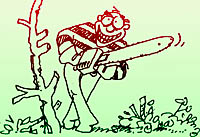Watch Out for Scam Artists Posing as ArboristsDownload the Full Kit In cooperation with the USDA Forest Service and the International Society of Arboriculture After a storm, it is common for people claiming to be tree specialists to show up at your door offering their services to remove or repair trees. In the words of one city forester: "They seem to come out of the woodwork, people we have never even heard of before." Unfortunately, many such individuals have little or no training, and sometimes have little interest in removing anything but money from the pocketbooks of unsuspecting residents. The Arbor Day Foundation urges you to not be a victim. "Make sure you are dealing with a reputable individual or tree care firm when you contemplate repairs or removal of any trees on your property," warns Matt Harris, Chief Executive of The Arbor Day Foundation. "Legitimate arborists rarely go door to door to solicit business." Here are eight guidelines to help you find qualified tree-care specialists: (special note for victims of large-scale disasters.) Note: During large-scale disasters — such as the aftermath of Hurricane Katrina in August, 2005 — many arborists from around the country may travel to help aid in recovery from widespread, catastrophic damage. In these special cases, it may not be practical to use a local professional. In addition, professional arborists may very well be knocking on doors as they participate in coordinated efforts to canvas large areas. Ask for proof of insurance. The insurance certificate will list a company name that you can call directly for verification. Number eight may not apply. There may be so many trees to remove that the value of trees for firewood or chips may be drastically reduced.
"Above all, don't be pressured into making a decision," Harris warns. "Taking the time to select a qualified tree professional can safeguard your trees and save you from the long-term consequences of wrong decisions about what to do about them after a storm." Illustration C1
Cutline: Hiring just anyone who shows up at your door may result in fatal damage to your trees. It's best to go with a qualified tree professional. Note to Editors:Many cities require arborists to be licensed and will maintain lists of firms and individuals so registered. You might check with your City Forester or other city officials who care for public trees in your communities. Sometimes this is a function of the city's parks department. |

